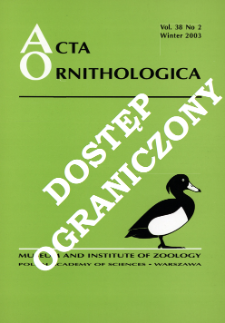
Object
Title: Winter abundance of hole-nesting birds in natural and managed woods of Zealand (Denmark)
Subtitle:
Acta Ornithologica, vol. 37, no. 2 ; Częstość występowania dziuplaków w naturalnych i zagospodarowanych lasach Zelandii (Dania) w okresie zimowym
Contributor:
Polska Akademia Nauk. Muzeum i Instytut Zoologii
Publisher:
Muzeum i Instytut Zoologii PAN
Place of publishing:
Description:
Bibliogr. s. 73 ; S. [67]-74 : il. ; 27 cm ; Streszcz. pol. Nazwy taksonów także w jęz. łac.
Type of object:
Abstract:
Foraging observations (1 observation/bird) of tits and associated species were recorded during four winter months in two natural old-growth and two managed forests. The number of daily foraging observations was used as an index of bird abundance. The daily mean number of foraging observations for Parus major, P. caeruleus, P. palustris, Sitta europea, Certhia familiaris and Dendrocopos major was significantly higher in natural old-growth vs managed forest [ratio 4.8:1 (all six species pooled) and ratios 3.1:1, 3.2:1, 4.7:1, 5.7:1, 7.4:1 and 4.7:1 for the above-mentioned species respectively]. As the larger dominant species has an advantage in competition for nest holes, we would expect these to exhibit the smallest abundance ratio skews. This was not, however, the case and consequently, the results of this study do not support the hypothesis that a lack of nest holes should be the primary limiting factor for hole nesting species in managed forests. It was found that the species showing the strongest preference for foraging on dead wood were the same that had the most pronounced density skew between forest types. This could indicate that the lack of food resulting from silvicultural practice could be very important as a limiting factor in managed forests. Analyses of the use of dead wood of different diameter and from different tree species indicate that forest birds exploit diverse types of dead wood. Partially decayed standing dead wood was the most important substrate for the majority of species.
Relation:
Volume:
Issue:
Start page:
End page:
Detailed Resource Type:
Format:
Resource Identifier:
Source:
MiIZ PAN, patrz sygn. czas. P.257-37-2 ; MiIZ PAN, patrz sygn. czas. P.4568-37-2 ; click here to follow the link
Language:
Rights:
Prawa zastrzeżone - dostęp ograniczony
Terms of use:
Digitizing institution:
Muzeum i Instytut Zoologii Polskiej Akademii Nauk
Original in:
Biblioteka Muzeum i Instytutu Zoologii PAN
Projects co-financed by:
Program Operacyjny Innowacyjna Gospodarka, lata 2010-2014, Priorytet 2. Infrastruktura strefy B + R ; Unia Europejska. Europejski Fundusz Rozwoju Regionalnego
Access:
Object collections:
- Digital Repository of Scientific Institutes > Partners' collections > Museum and Institute of Zoology PAS > Scientific Journals
- Digital Repository of Scientific Institutes > Partners' collections > Museum and Institute of Zoology PAS > MIZ PAN Publications > Acta Ornithologica
- Digital Repository of Scientific Institutes > Literature > Journals/Articles
Last modified:
Oct 2, 2020
In our library since:
Jun 10, 2014
Number of object content downloads / hits:
92
All available object's versions:
https://rcin.org.pl/publication/55574
Show description in RDF format:
Show description in RDFa format:
Show description in OAI-PMH format:
| Edition name | Date |
|---|---|
| Winter abundance of hole-nesting birds in natural and managed woods of Zealand (Denmark) / Bursell, Jens | Oct 2, 2020 |
Objects Similar
Bai, Mei-Ling (1975– ) Wichmann, Frank Mühlenberg, Michael (1944– )
Jenni, Lukas
Bai, Mei-Ling (1975– ) Wichmann, Frank. Mühlenberg, Michael (1944– ) Polska Akademia Nauk. Muzeum i Instytut Zoologii.
Maheswaran, Balaraman Balasubramanian, Paramasivam
Witt, Klaus
Gromadzki, Maciej

 INSTYTUT ARCHEOLOGII I ETNOLOGII POLSKIEJ AKADEMII NAUK
INSTYTUT ARCHEOLOGII I ETNOLOGII POLSKIEJ AKADEMII NAUK
 INSTYTUT BADAŃ LITERACKICH POLSKIEJ AKADEMII NAUK
INSTYTUT BADAŃ LITERACKICH POLSKIEJ AKADEMII NAUK
 INSTYTUT BADAWCZY LEŚNICTWA
INSTYTUT BADAWCZY LEŚNICTWA
 INSTYTUT BIOLOGII DOŚWIADCZALNEJ IM. MARCELEGO NENCKIEGO POLSKIEJ AKADEMII NAUK
INSTYTUT BIOLOGII DOŚWIADCZALNEJ IM. MARCELEGO NENCKIEGO POLSKIEJ AKADEMII NAUK
 INSTYTUT BIOLOGII SSAKÓW POLSKIEJ AKADEMII NAUK
INSTYTUT BIOLOGII SSAKÓW POLSKIEJ AKADEMII NAUK
 INSTYTUT CHEMII FIZYCZNEJ PAN
INSTYTUT CHEMII FIZYCZNEJ PAN
 INSTYTUT CHEMII ORGANICZNEJ PAN
INSTYTUT CHEMII ORGANICZNEJ PAN
 INSTYTUT FILOZOFII I SOCJOLOGII PAN
INSTYTUT FILOZOFII I SOCJOLOGII PAN
 INSTYTUT GEOGRAFII I PRZESTRZENNEGO ZAGOSPODAROWANIA PAN
INSTYTUT GEOGRAFII I PRZESTRZENNEGO ZAGOSPODAROWANIA PAN
 INSTYTUT HISTORII im. TADEUSZA MANTEUFFLA POLSKIEJ AKADEMII NAUK
INSTYTUT HISTORII im. TADEUSZA MANTEUFFLA POLSKIEJ AKADEMII NAUK
 INSTYTUT JĘZYKA POLSKIEGO POLSKIEJ AKADEMII NAUK
INSTYTUT JĘZYKA POLSKIEGO POLSKIEJ AKADEMII NAUK
 INSTYTUT MATEMATYCZNY PAN
INSTYTUT MATEMATYCZNY PAN
 INSTYTUT MEDYCYNY DOŚWIADCZALNEJ I KLINICZNEJ IM.MIROSŁAWA MOSSAKOWSKIEGO POLSKIEJ AKADEMII NAUK
INSTYTUT MEDYCYNY DOŚWIADCZALNEJ I KLINICZNEJ IM.MIROSŁAWA MOSSAKOWSKIEGO POLSKIEJ AKADEMII NAUK
 INSTYTUT PODSTAWOWYCH PROBLEMÓW TECHNIKI PAN
INSTYTUT PODSTAWOWYCH PROBLEMÓW TECHNIKI PAN
 INSTYTUT SLAWISTYKI PAN
INSTYTUT SLAWISTYKI PAN
 SIEĆ BADAWCZA ŁUKASIEWICZ - INSTYTUT TECHNOLOGII MATERIAŁÓW ELEKTRONICZNYCH
SIEĆ BADAWCZA ŁUKASIEWICZ - INSTYTUT TECHNOLOGII MATERIAŁÓW ELEKTRONICZNYCH
 MUZEUM I INSTYTUT ZOOLOGII POLSKIEJ AKADEMII NAUK
MUZEUM I INSTYTUT ZOOLOGII POLSKIEJ AKADEMII NAUK
 INSTYTUT BADAŃ SYSTEMOWYCH PAN
INSTYTUT BADAŃ SYSTEMOWYCH PAN
 INSTYTUT BOTANIKI IM. WŁADYSŁAWA SZAFERA POLSKIEJ AKADEMII NAUK
INSTYTUT BOTANIKI IM. WŁADYSŁAWA SZAFERA POLSKIEJ AKADEMII NAUK


































